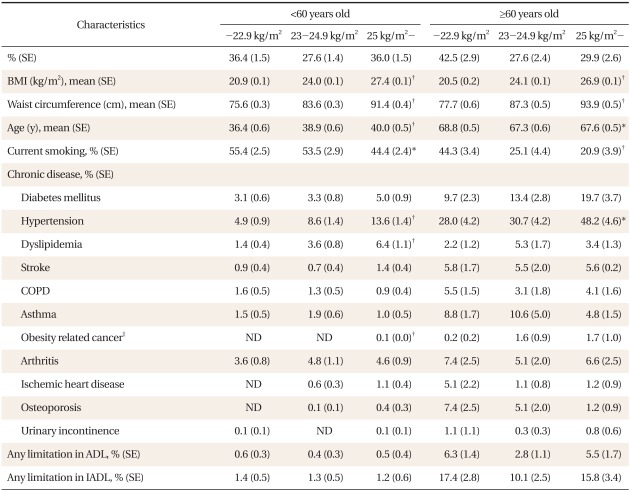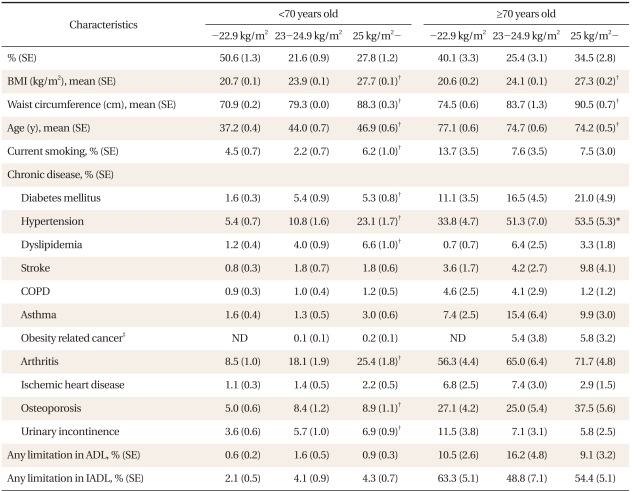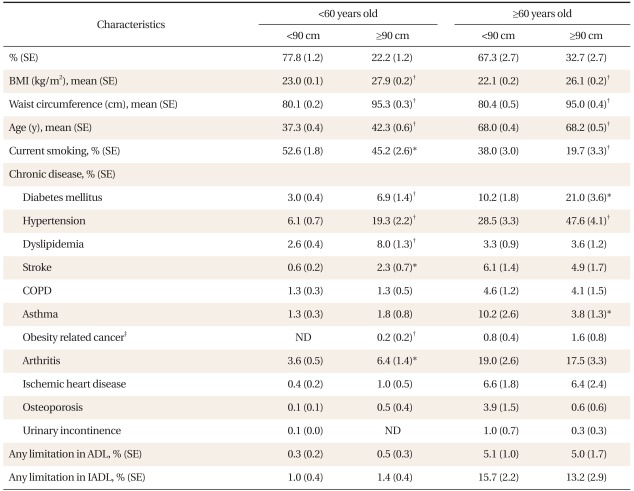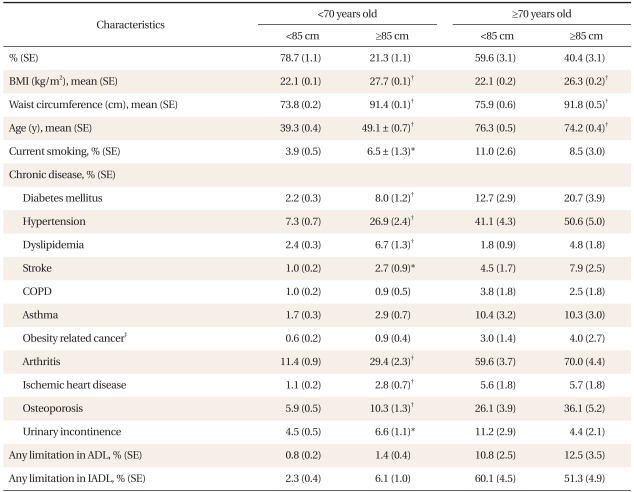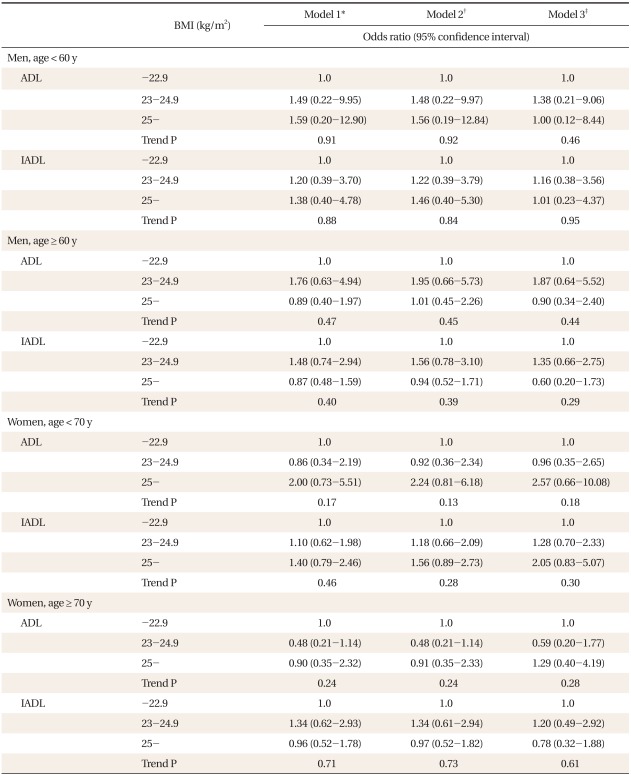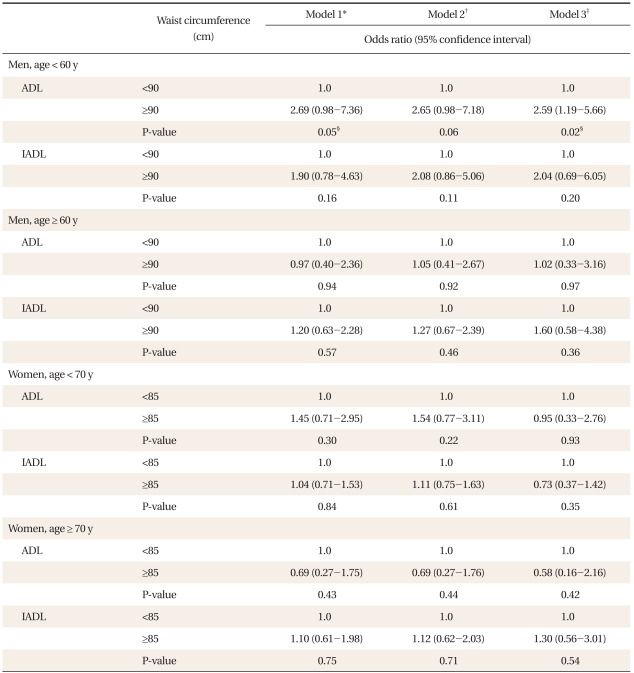Abstract
Background
Obesity increases the risk of many chronic diseases and contributes to functional disabilities. We assessed the relationship among obesity and obesity related chronic disease and disability in Korean adults.
Methods
This study used data from the 2005 Korean National Health and Nutrition Examination Survey. A total of 5,462 persons (2,325 men, 3,137 women) aged 20 years and older were included in this analysis. Obesity was measured by body mass index and abdominal obesity was by waist circumference. Information on the presence of chronic diseases was based on the self-report of having been diagnosed by physicians. Functional disability was assessed using the Korean activities of daily living (K-ADL) and the Korean instrumental ADL (K-IADL) scales.
Results
The relationship between obesity and prevalence of obesity-related chronic diseases was higher in the older aged group (>60 years for men, >70 years for women) than in the younger aged group. Waist circumference was more related to a higher prevalence of chronic diseases than body mass index in the younger aged group. Abdominal obesity increased the risk (odds ratio, 2.59; 95% confidence interval, 1.19 to 5.66) of having limitation in activities of daily living for the younger aged men after adjustments for age, smoking status, presence of chronic diseases, and body mass index. Body mass index was not associated with disability in either men or women.
Conclusion
The association between obesity and prevalence of chronic disease differed depending on age and sex. It is important to control abdominal obesity to prevent disability in younger aged men.
Keywords: Obesity, Disability, Waist Circumference, Body Mass Index, Activities of Daily Living
INTRODUCTION
Physical functional status is one of the major determinants of a healthy and active life and obesity is a major risk factor of functional disability.1,2) Obesity leads to musculoskeletal overloads and causes chronic diseases such as hypertension, diabetes, and hyperlipidemia through metabolic syndrome, which in turn leads to atherosclerotic diseases including cerebrovacular disease, coronary heart disease, chronic renal disease, and heart failure.3) These diseases could result in functional disability.2,4) In addition, chronic inflammatory status caused by obesity is a risk factor for chronic diseases such as colon cancer.5) Al Snih et al.6) reported that body mass index (BMI) is positively correlated with physical disability above nadir BMI value.
Although the proportion of obese population is increasing, Koreans are still the 2nd slimmest people among Organization for Economic Co-operation and Development (OECD) countries after Japan, with a prevalence of overweight or obesity of 30.5%.7) In Korea, both weight status and weight change by aging is somewhat different from the West. BMI increases until 75 years old in American men and women both.8) However, it increases only until 60 years old in Korean men and 70 years in Korean women.9)
Asians have a higher percent fat than Western people with similar BMI, which make them more prone to type 2 diabetes and cardiovascular diseases.10) Therefore, it is not certain that the relationship among obesity, obesity related chronic diseases and functional disability observed in the West could be replicated in Koreans. We should also keep in mind that the functional disability influences the clinical course of chronic diseases and that medical treatments for them also affect body weight and body composition. Furthermore, aging processes accompanying the natural course of chronic diseases additionally affect body weight and body composition.
Studies on obesity in Korea have focused mainly on cardiovascular disease and metabolic syndrome. Relatively little attention was given to other obesity related diseases or to the relationship between obesity and functional disability. We could confirm only one study on this topic, which is by Cho et al.11) They reported that the Instrumental Activities of Daily Living (IADL) was high in the elderly overweight group participating the 1998 Korea National Health and Nutrition Examination Survey (KNHANES). They used the Katz index, which was criticized as having poor reflections of cultural differences.12,13) Therefore, researches on the correlation between obesity and functional disability in Korean adults, including young and middle age groups, measured with instruments with proven reliability and validity are needed. This study is to assess the relationship among obesity, obesity related chronic diseases and functional disability in Korean adults using 2005 KNHANES.
METHODS
1. KNHANES and Study Participants
The KNHANES is a triennial survey to investigate the health and nutritional status of Korean people. The 2005 KNHANES is the third survey following the 1998 and 2001 surveys and was implemented from April to June, 2005. It consists of the Health Interview Survey (HIS), the Nutrition Survey (NS), and the Health Examination Study (HES). Our analytic sample includes 5,462 individuals (2,325 men, 3,137 women) aged 20 years or older, who completed all three components in the KNHANES III. Detailed descriptions of the sample selection and study procedure are described elsewhere.14)
2. Sociodemographic Factors, Health Behaviors, and Past Medical History
Data on the sociodemographic factors, health behaviors, and past medical history were obtained through self-administered questionnaires. The participants were asked to fill out the questionnaires. If participants had difficulties, trained interviewers implemented interviews. Smoking status was categorized as smoker or nonsmoker based on current smoking status. Past medical history of obesity related diseases such as hypertension, diabetes, hyperlipidemia, stroke, ischemic heart disease, cancer (colon or breast), arthritis, asthma, chronic obstructive pulmonary disease, and urinary incontinence was confirmed with the question 'have you ever been diagnosed as having the disease by physicians?' If participants said 'yes', he or she was regarded as having the disease.
3. Anthropometric Measurements
Height was measured to the nearest 0.1 cm on a stadiometer (Seca 225; Seca Deutschland, Hamburg, Germany). Body weight was mea sured to the nearest 0.1 kg on a balance scale (GL-6000-20, Cas, Yangju, Korea) with the subject wearing a lightweight gown or underwear. Waist circumference was measured at a level midway between the lowest rib and the iliac crest by placing the measuring tape horizontally around the participant's abdomen during normal breathing.
Obesity was measured by BMI and abdominal obesity was by waist circumference. BMI was classified into less than 22.9 kg/m2 (normal), 23-24.9 kg/m2 (overweight), over 25 kg/m2 (obese) according to the standard of WHO (Asia Pacific regional guideline) and the Korean Society for the Study of Obesity (KSSO). The proportion of participants with BMI less than 22.9 kg/m2 was 4.2% and we reclassified them into normal weight groups. Waist circumference was categorized into less than 90 cm and over 90 cm for men, and less than 85 cm and over 85 cm for women by the standards of the KSSO.
4. Functional Disability Assessment Tools
Functional disability was assessed using the Korean Activities of Daily Living (K-ADL) and the Korean Instrumental ADL (K-IADL) scales. The K-ADL consists of seven items: dressing, facial washing, bathing, self feeding, ambulation, getting onto or off of toilet, and bowel and bladder management. The K-IADL includes 10 items: grooming, housework, meal preparation, cleaning laundry, community mobility, use of communication devices, shopping for groceries or clothing, managing money, using telephone, and taking medications as prescribed.
For each item, participants were asked to give one of following answers: 'can do independently', 'partially dependant on others', and 'fully dependant on others'. The K-IADL additionally includes 'do not do' for the items of housework, meal preparation, cleaning laundry, and money management. The reliability and validity of K-ADL and K-IADL have been evaluated. For this study, we defined 'functional disability' as 'having more than one item of the K-ADL or K-IADL responded as partially or fully dependent on others'.
5. Statistical Analysis
All analyses used 'complex samples analysis' option from SPSS ver. 18.0 (SPSS Inc., Chicago, IL, USA) to account for the sampling weight from the multistage, stratified, and clustered sampling of KNHANES. When the survey weight was applied, 2,325 male participants represented 17,520,000 Korean adult men and 3,137 female participants represented 17,600,000 Korean adult women, totaling 35,120,000 adults (data not shown).
All analysis was done after stratification by sex and age group. Age cut-off values for stratification were 60 years old for men and 70 years old for women, i.e., from when BMI of Korean adults starts to decrease.9) Men and women less than the cut-off age were 'young adults and middle aged group (YMG)' and 'old aged group (OG)' if they were over the cut-off value.
The basic characteristics of the study population were expressed as mean or percentages with standard error (SE). Multivariate logistic regression modeling was used to test the association between BMI, waist circumference, and functional disability. Age and smoking status were adjusted in model I and further adjustments of chronic disease were used in model II. In model III, waist circumference was additionally adjusted on model II for the relationship between BMI and functional disability. BMI was also adjusted in model III to test the relationship between waist circumference and functional disability. Statistical significance was defined as a P < 0.05.
RESULTS
1. Sociodemographic Characteristics and Obesity Related Chronic Diseases by BMI (Tables 1 and 2)
Table 1.
Baseline characteristics by BMI in Korean men.
BMI: body mass index, SE: standard error, COPD: chronic obstructive pulmonary disease, ND: not detectable, ADL: activities of daily living, IADL: instrumental activities of daily living.
*P < 0.05. †P < 0.01 by linear regression analysis for continuous variables or logistic regression analysis for categorical variables. ‡Obesity related cancer included breast cancer and colon cancer.
Table 2.
Baseline characteristics by BMI in Korean women.
BMI: body mass index, SE: standard error, COPD: chronic obstructive pulmonary disease, ND: not detectable, ADL: activities of daily living, IADL: instrumental activities of daily living.
*P < 0.05. †P < 0.01 by linear regression analysis for continuous variables or logistic regression analysis for categorical variables. ‡Obesity related cancer included breast cancer and colon cancer.
A higher BMI was associated with a higher waist circumference for all four groups (all P < 0.01) and with a higher age for both sexes YMG (all P < 0.01). In OG, a higher BMI was negatively associated with age (P for men < 0.05, for women < 0.01).
A higher BMI was associated with hypertension, hyperlipidemia, and obesity related cancers in YMG for both sexes. Diabetes, arthritis, osteoporosis, and urinary incontinence were associated only in women. For both sex OG, only hypertension was related with a higher BMI.
ADL and IADL limitations were more prevalent in women than in men, and more prevalent in OG than in YMG. The prevalence of IADL was higher than ADL in all age and sex categories. These findings were consistent after further adjustment of age and smoking status (data not shown).
2. Sociodemographic Characteristics and Obesity Related Chronic Diseases by Waist Circumference (Tables 3 and 4)
Table 3.
Baseline characteristics by waist circumference in Korean men.
BMI: body mass index, SE: standard error, COPD: chronic obstructive pulmonary disease, ND: not detectable, ADL: activities of daily living, IADL: instrumental activities of daily living.
*P < 0.05. †P < 0.01 by linear regression analysis for continuous variables or logistic regression analysis for categorical variables. ‡Obesity related cancer included breast cancer and colon cancer.
Table 4.
Baseline characteristics by waist circumference in Korean women.
SE: standard error, BMI: body mass index, COPD: chronic obstructive pulmonary disease, ADL: activities of daily living, IADL: instrumental activities of daily living.
*P < 0.05. †P < 0.01 by linear regression analysis for continuous variables or logistic regression analysis for categorical variables. ‡Obesity related cancer included breast cancer and colon cancer.
The abdominal obesity groups were older than normal waist circumference group for both sex YMG and male OG (all P < 0.01), while they were younger for female OG (P < 0.01). The abdominal obesity groups from both sex YMG had higher prevalence of diabetes (3.0 ± 0.4% vs. 6.9 ± 1.4%, 2.2 ± 0.3% vs. 8.0 ± 1.2%, respectively), hypertension (6.1 ± 0.7% vs. 19.3 ± 2.2%, 7.3 ± 0.7% vs. 26.9 ± 2.4%), hyperlipidemia (2.6 ± 0.4% vs. 8.0 ± 1.3%, 2.4 ± 0.3% vs. 6.7 ± 1.3%), stroke (0.6 ± 0.2% vs. 2.3 ± 0.7%, 1.0 ± 0.2% vs. 2.7 ± 0.9%), and arthritis (3.6 ± 0.5% vs. 6.4 ± 1.4%, 11.4 ± 0.9% vs. 29.4 ± 2.3%). In women, coronary heart disease (1.1 ± 0.2 vs. 2.8 ± 0.7), osteoporosis (5.9 ± 0.5 vs. 10.3 ± 1.3), and urinary incontinence (4.5 ± 0.5 vs. 6.6 ± 1.1) were also more prevalent. The prevalence of ADL and IADL were higher in women than in men, and in OG than in YMG (data not shown).
3. Functional Disability by BMI (Table 5)
Table 5.
Odds of having disability by BMI.
P-value < 0.05 by multivariate logistic regression modeling.
BMI: body mass index, ADL: activities of daily living, IADL: instrumental activities of daily living.
*Adjusting for age (continuous) and smoking (yes or no). †Further adjusting for the presence of individual chronic diseases (yes or no).
‡Further adjusting for waist circumference (men, <90 cm or ≥90 cm; women, <85 cm or ≥85 cm).
ADL and IADL limitation increased as BMI increases in both sex YMG, although there was no statistical significance. In both sex OG, no significant associations were observed. The risk of ADL and IADL limitation was associated with a higher BMI in model I and model II. However, the risk converged to 1 in model III further adjusted for waist circumference.
4. Functional Disability by Waist Circumference (Table 6)
Table 6.
Odds of having disability by waist circumference.
ADL: activities of daily living, IADL: instrumental activities of daily living.
*Adjusting for age (continuous) and smoking (yes or no). †Further adjusting for the presence of individual chronic diseases (yes or no).
‡Further adjusting for body mass index (-22.9 kg/m2, 23-24.9 kg/m2, or 25 kg/m2). §P-value < 0.05 by multivariate logistic regression modelings.
The odds ratio (OR) of abdominal obesity for functional disability in men YMG was 2.69 (95% confidence interval [CI], 0.98 to 7.36). This association was consistent in model II which adjusted for obesity related diseases and in model III which further adjusted for BMI (OR, 2.59; CI, 1.19 to 5.66). In women, both YMG and OG showed no significant relationship between waist circumference and functional disability.
DISCUSSION
This study assessed the association of obesity and abdominal obesity measured by BMI and waist circumference with obesity related chronic diseases and functional disability measured by K-ADL, K-IADL. In YMG, a higher BMI was associated with a higher prevalence of hypertension (men and women), hyperlipidemia (men and women), obesity related cancers (men), diabetes (women), arthritis (women), osteoporosis (women), and urinary incontinence (women), and abdominal obesity was associated with diabetes (men and women), hypertension (men and women), hyperlipidemia (men and women), arthritis (men and women), coronary heart disease (women), osteoporosis (women), and urinary incontinence (women).
Considering that a lower BMI is a proven risk factor of osteoporosis,15) our results showing that obese adults have a higher prevalence of osteoporosis is an unexpected result. However, a recent study reported the possibility that the distribution of adipose tissue is another determinant of bone metabolism, and visceral adipose tissue influences bone tissue negatively.16) A higher prevalence of osteoporosis in the abdominal obesity group is comparable to recent findings on bone mineral density and fat tissue.
The abdominal obesity group of male OG had a lower prevalence of asthma (10.2 ± 2.6% vs. 3.8 ± 1.3%) than the normal waist circumference group. Our findings are somewhat contrary to previous results that obesity aggravates asthma,17) and weight reduction by obesity treatments decrease the frequency of exacerbation.18) We suggest several explanations on these findings. First, severe asthma decreases oral intake and physical activity and hence induce weight loss.19) Second, asthma of the elderly is sometimes misdiagnosed as chronic obstructive pulmonary disease (COPD) or congestive heart failure and often accompanied by them.20) Therefore, in the abdominal obesity group who often have chronic diseases, diagnosis of asthma might be missed or misdiagnosed. We confirmed asthma by history taking instead of physical examinations or laboratory tests, which might have hampered the exact estimation of asthma prevalence.
The relationship between obesity and obesity related chronic disease was more marked in YMG than in OG who started to lose weight. For example, the prevalence of hypertension, diabetes, hypelipidemia, arthritis, osteoporosis, and urinary incontinence increased as BMI increased in YMG. However, only the hypertension prevalence increased in OG.
The weak association observed in OG was likely due to the following. First, obese persons might expire earlier by obesity related disease such as coronary heart disease and stroke and do not survive into OG age (survival effect).21) Second, aging related unintentional weight loss observed in the elderly is partly due to underlying disease.22) Therefore, the lower BMI group has a higher probability of co-morbid diseases in OG,23) which might make the association between obesity index and chronic diseases less marked in OG.
We used BMI and waist circumference as obesity index. Waist circumference, a marker of abdominal obesity, was a more predictive marker for obesity related chronic diseases. These findings are consistent with Zhu et al.24) who reported that waist circumference is more predicative for cardiovascular disease than BMI and with Janssen et al.25) who reported that waist circumference is a valuable tool to access obesity related health risks.
The relationships between obesity and obesity related diseases differed by sex. As the degree of obesity increase, women have more diseases than men. However, overseas studies reported men might be more vulnerable to obesity related disease because men have more intra-abdominal fat and higher insulin resistance than women with the same weight. Furthermore, men have less estrogen and adiponectin which have important roles in glucose homeostasis and fat tissue distribution.25)
We used different age cutoffs for men (60 year old) and women (70 year old). The women YMG included women in their 60s who have a higher prevalence of chronic diseases, which made women YMG show a higher prevalence of obesity related chronic diseases than men YMG.
There have been many studies on the relationship between obesity and disability in overseas countries. Al Snih et al.6) reported that ADL and mortality increase as BMI increases in Whites, Blacks, and Mexicans when BMI is over 24 kg/m2. Woo et al.26) reported that a higher BMI and fat percent increases IADL in Chinese.
This study showed that BMI is not related to disability in Korean and that abdominal obesity measured by waist circumference is a risk factor of ADL limitation by 2.7. This relationship is significant even after statistical adjustments of obesity related chronic diseases and BMI. This means that waist circumference is a more predictive variable of disability than BMI in men YMG and obesity might be a risk factor of disability regardless of obesity related chronic diseases. Our results are very similar to finding of Chen and Guo.4) They also reported that waist circumference is a more valuable predictor of disability than BMI and could be a direct causative factor of disability.
Waist circumference reflects the amount of intra-abdominal fat deposition and visceral obesity. Visceral fat rather than subcutaneous fat induces obesity related chronic diseases, which in turn cause disability. Obesity induces chronic inflammation which reduces muscle mass and increases bone absorption.26-28) Therefore, abdominal obesity proved to be a risk factor to be controlled to prevent disability.
The K-ADL is used for elderly with functional disability as an objective measure evaluating the aging process and rehabilitation course.29) K-IADL is often applied to elderly in community dwellings to evaluate functional status and to inpatients planning discharge to assess the probability of social readjustment.29) Both instruments have been validated in Korean to assess the functional disability of Korean people.
Our study has weaknesses that deserve mention. First, we could not tell the causal relationship because of the cross-sectional design. Second, we did not consider the past history of fracture or fall, muscle power, and cognitive function, which were not measured in KNHANES. Third, the diagnosis of obesity related disease was based on the questionnaire instead of more objective measures, which made more precise estimation of prevalence impossible. Fourth, because of low prevalence of disability in YMG, women YMG group showed wide confidence interval, which resulted in a statistical non-significance.
Despite some limitation, this study focused on the relationship between obesity and obesity related diseases and further on obesity and disability while most studies in Korea mainly focused on cardiovascular disease and metabolic syndrome. We also used validated measures of disability for Korean.
Obesity is related with obesity related disease and disability in Korea YMG. However, these relationships are attenuated in OG Korean. Korean YMG men with abdominal obesity have an increased risk of disability and management of abdominal obesity is advised in order to have active life without disabilities.
References
- 1.Field AE, Coakley EH, Must A, Spadano JL, Laird N, Dietz WH, et al. Impact of overweight on the risk of developing common chronic diseases during a 10-year period. Arch Intern Med. 2001;161:1581–1586. doi: 10.1001/archinte.161.13.1581. [DOI] [PubMed] [Google Scholar]
- 2.Peeters A, Bonneux L, Nusselder WJ, De Laet C, Barendregt JJ. Adult obesity and the burden of disability throughout life. Obes Res. 2004;12:1145–1151. doi: 10.1038/oby.2004.143. [DOI] [PubMed] [Google Scholar]
- 3.Sturm R, Ringel JS, Andreyeva T. Increasing obesity rates and disability trends. Health Aff (Millwood) 2004;23:199–205. doi: 10.1377/hlthaff.23.2.199. [DOI] [PubMed] [Google Scholar]
- 4.Chen H, Guo X. Obesity and functional disability in elderly Americans. J Am Geriatr Soc. 2008;56:689–694. doi: 10.1111/j.1532-5415.2007.01624.x. [DOI] [PMC free article] [PubMed] [Google Scholar]
- 5.Frezza EE, Wachtel MS, Chiriva-Internati M. Influence of obesity on the risk of developing colon cancer. Gut. 2006;55:285–291. doi: 10.1136/gut.2005.073163. [DOI] [PMC free article] [PubMed] [Google Scholar]
- 6.Al Snih S, Ottenbacher KJ, Markides KS, Kuo YF, Eschbach K, Goodwin JS. The effect of obesity on disability vs mortality in older Americans. Arch Intern Med. 2007;167:774–780. doi: 10.1001/archinte.167.8.774. [DOI] [PubMed] [Google Scholar]
- 7.Organisation for Economic Co-operation and Development. OECD health data 2008. Paris: Organisation for Economic Co-operation and Development; 2009. [Google Scholar]
- 8.Ogden CL, Fryar CD, Carroll MD, Flegal KM. Mean body weight, height, and body mass index, United States 1960-2002. Adv Data. 2004;(347):1–17. [PubMed] [Google Scholar]
- 9.Korean Agency for Technology and Standards, Ministry of Knowledge and Economy. 5th Size Korea [Internet] Gwacheon: Korean Agency for Technology and Standards; 2004. [cited 2011 Oct 20]. Available from: http://sizekorea.kats.go.kr. [Google Scholar]
- 10.James WP, Chunming C, Inoue S. Appropriate Asian body mass indices? Obes Rev. 2002;3:139. doi: 10.1046/j.1467-789x.2002.00063.x. [DOI] [PubMed] [Google Scholar]
- 11.Cho SH, Kwon BK, Lee SN, Choi JY, Shin YK, Jee SH. The relationship between obesity and functional status in the Korean elderly: an analysis of Korean National Health and Nutrition Examination Survey, 1998. J Korean Acad Fam Med. 2002;23:1440–1452. [Google Scholar]
- 12.Won CW, Rho YG, SunWoo D, Lee YS. The validity and reliability of Korean Instrumental Activities of Daily Living (K-IADL) scale. J Korean Geriatr Soc. 2002;6:273–280. [Google Scholar]
- 13.Won CW, Rho YG, Kim SY, Cho BR, Lee YS. The validity and reliability of Korean Activities of Daily Living (K-ADL) scale. J Korean Geriatr Soc. 2002;6:98–106. [Google Scholar]
- 14.Korea Centers for Disease Control and Prevention. The Third Korea National Health and Nutrition Examination Survey (KNHANES III) Seoul: Korea Centers for Disease Control and Prevention; 2006. [Google Scholar]
- 15.National Osteoporosis Foundation. Clinician's guide to prevention and treatment of osteoporosis. Washington, DC: National Osteoporosis Foundation; 2010. [Google Scholar]
- 16.Kim CJ, Oh KW, Rhee EJ, Kim KH, Jo SK, Jung CH, et al. Relationship between body composition and bone mineral density (BMD) in perimenopausal Korean women. Clin Endocrinol (Oxf) 2009;71:18–26. doi: 10.1111/j.1365-2265.2008.03452.x. [DOI] [PubMed] [Google Scholar]
- 17.Murugan AT, Sharma G. Obesity and respiratory diseases. Chron Respir Dis. 2008;5:233–242. doi: 10.1177/1479972308096978. [DOI] [PubMed] [Google Scholar]
- 18.Eneli IU, Skybo T, Camargo CA., Jr Weight loss and asthma: a systematic review. Thorax. 2008;63:671–676. doi: 10.1136/thx.2007.086470. [DOI] [PubMed] [Google Scholar]
- 19.Luder E, Ehrlich RI, Lou WY, Melnik TA, Kattan M. Body mass index and the risk of asthma in adults. Respir Med. 2004;98:29–37. doi: 10.1016/j.rmed.2003.08.004. [DOI] [PubMed] [Google Scholar]
- 20.McCullough PA, Hollander JE, Nowak RM, Storrow AB, Duc P, Omland T, et al. Uncovering heart failure in patients with a history of pulmonary disease: rationale for the early use of B-type natriuretic peptide in the emergency department. Acad Emerg Med. 2003;10:198–204. doi: 10.1111/j.1553-2712.2003.tb01990.x. [DOI] [PubMed] [Google Scholar]
- 21.Elia M. Obesity in the elderly. Obes Res. 2001;9(Suppl 4):244S–248S. doi: 10.1038/oby.2001.126. [DOI] [PubMed] [Google Scholar]
- 22.Wannamethee SG, Shaper AG, Whincup PH, Walker M. Characteristics of older men who lose weight intentionally or unintentionally. Am J Epidemiol. 2000;151:667–675. doi: 10.1093/oxfordjournals.aje.a010261. [DOI] [PubMed] [Google Scholar]
- 23.Zamboni M, Mazzali G, Zoico E, Harris TB, Meigs JB, Di Francesco V, et al. Health consequences of obesity in the elderly: a review of four unresolved questions) Int J Obes (Lond) 2005;29:1011–1029. doi: 10.1038/sj.ijo.0803005. [DOI] [PubMed] [Google Scholar]
- 24.Zhu S, Heymsfield SB, Toyoshima H, Wang Z, Pietrobelli A, Heshka S. Race-ethnicity-specific waist circumference cutoffs for identifying cardiovascular disease risk factors. Am J Clin Nutr. 2005;81:409–415. doi: 10.1093/ajcn.81.2.409. [DOI] [PubMed] [Google Scholar]
- 25.Janssen I, Katzmarzyk PT, Ross R. Waist circumference and not body mass index explains obesity-related health risk. Am J Clin Nutr. 2004;79:379–384. doi: 10.1093/ajcn/79.3.379. [DOI] [PubMed] [Google Scholar]
- 26.Woo J, Leung J, Kwok T. BMI, body composition, and physical functioning in older adults. Obesity (Silver Spring) 2007;15:1886–1894. doi: 10.1038/oby.2007.223. [DOI] [PubMed] [Google Scholar]
- 27.Andrews NC. Anemia of inflammation: the cytokine-hepcidin link. J Clin Invest. 2004;113:1251–1253. doi: 10.1172/JCI21441. [DOI] [PMC free article] [PubMed] [Google Scholar]
- 28.Ferrucci L, Penninx BW, Volpato S, Harris TB, Bandeen-Roche K, Balfour J, et al. Change in muscle strength explains accelerated decline of physical function in older women with high interleukin-6 serum levels. J Am Geriatr Soc. 2002;50:1947–1954. doi: 10.1046/j.1532-5415.2002.50605.x. [DOI] [PubMed] [Google Scholar]
- 29.Won CW. K-ADL and K-IADL. J Korean Acad Fam Med. 2002;23(4 Suppl):188S–197S. [Google Scholar]



